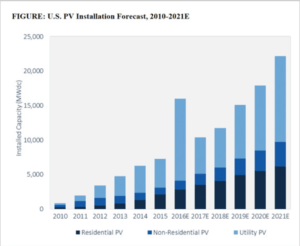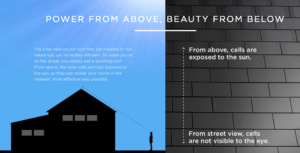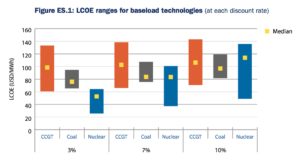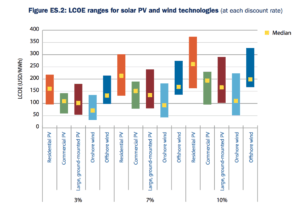SolarCity – Climate Change Winner or a Dud?

Is SolarCity a viable business model or not?
As climate change moves to the forefront of global debate, reducing the 12% share of GHG emissions attributable to powering and heating buildings1 is becoming an increasingly appealing way to reduce global GHG emissions. In the United States, taking advantage of a 30% Solar Investment Tax Credit toward residential and commercial solar projects2, numerous firms have sprung up offering homeowners and businesses the chance to install solar panels on their roof, reducing their electricity intake and GHG emissions. One of these firms is SolarCity
The good – scaling quickly in response to an important problem
SolarCity has aggressively grown in response to this climate change opportunity to become the largest designer and installer of solar power systems in the United States, having installed over 280,000 solar systems representing ~2300 megawatts (MW) of capacity as of 6/30/163. For every hour these customers use electricity, this prevents ~1500 – 2500 tons of CO2 emissions4. Additionally, excess power generated is stored in onsite batteries for use at night, further reducing emissions
SolarCity continues to grow quickly, its total MW installed having increased 66% over the previous 12 months to June 2016. Given the rapid expected growth of this market5, and the fact that the US supplied almost 2.5 million MW of energy in 20101, this growth could continue unabated for a long period of time.
On the product development side, SolarCity’s pace of innovation has not slowed, with the firm recently introducing a “solar roof,” where instead of mounting solar panels on an existing roof, SolarCity will sell and install a roof made of thin solar panels that are invisible from street level6
Just as SolarCity’s willingness to expand can’t be doubted, nor can its willingness to embrace change. Pending a shareholder vote, SolarCity has agreed to be acquired by Tesla, in a move that some believe will dramatically expand SolarCity’s reach, provide a long term battery supplier for SolarCity and potentially create a “one-stop-shop” for all a customers sustainable needs, allowing customers to purchase an electric car and the means to sustainably charge it under one roof7.
The bad – how sustainable is this business?
SolarCity’s impressive growth notwithstanding, there remain some key questions surrounding its future. Primarily, SolarCity has never been profitable in 10 years of operation, burned ~$800M in operating cash in FY2015, and is in questionable financial health with over $1B in debt on its balance sheet8. Even as part of Tesla, these results do not bode well for SolarCity’s long-term viability.
Additionally, there are some questions regarding the quality of SolarCity’s latest products, with some questioning the potential quality and cost of the Solar Roof9 and SolarCity providing little in the way of supporting details.
Perhaps more worryingly, SolarCity has failed to reduce costs over time, the cost per installed watt having actually risen 2% in the past two years due to escalating sales costs10.
This is worrisome, since that SolarCity has set a target for itself of $2.30 / watt by 2017, and that residential solar is still uncompetitive with other sources of energy, costing at least 50% more on a levelized basis compared with conventional fuel sources11. Given that the Solar Investment Tax Credit is currently set to expire in 20232, SolarCity must continue to improve.
The future – a path toward sustainability
Going forward, SolarCity’s future potential is equaled only by challenges it faces validating its operating model. To ensure its success in its mission to provide renewable energy, two things must happen:
- SolarCity must continue to innovate to make its systems an economic, not just an environmental, choice for more Americans, and that means reducing costs and scaling responsibly
- One potential option is to explore partnership models with utilities, who currently have little incentive to support Solar City as it typically implies a reduced consumption base to amortize high fixed costs
- Another option is to begin using 3rd party installers in remote locations. While SolarCity has prided itself on being a full-service vertically integrated installer, this could allow them to achieve greater scale at lower fixed cost
- Additionally, SolarCity must continue to strive for a product that is minimally intrusive and easy to install to maximize uptake. Whether this is Solar Roof or a redesign of its traditional solar panels to improve their aesthetic, it is imperative that Solar City remove as many emotional or logistical barriers to installation as possible
The future is bright as SolarCity seeks to tackle an urgent problem with global implications, we can only hope no clouds are in the way
Word Count: 750
Footnotes / Sources
[1] Climate Change in 2016: Implications for Business (HBS No. 317-032)
[2] http://www.seia.org/policy/finance-tax/solar-investment-tax-credit, 11/3/16
[3] SCTY Q2 2016 Form 10-Q, pg 36
[4] EIA FAQ’s. Analysis depends on choice of generation alternative, numbers taken from https://www.eia.gov/tools/faqs/faq.cfm?id=74&t=11 11/3/16
[5] GTM research, Solar Market Insight Report 2015 Year in Review, found at: http://www.seia.org/news/us-solar-market-set-grow-119-2016-installations-reach-16-gw
[6] SolarCity website
[7] http://www.usatoday.com/story/money/cars/2016/11/01/elon-musk-touts-solarcitys-benefit-tesla/93146370/, 11/3/16
[8] Numbers taken from SCTY FY 2015 Form 10-K
[9] http://www.popsci.com/five-questions-we-still-have-about-musks-new-solar-roofs, 11/3/16
[10] SCTY Q2 2016 Earnings Presentation, pg 6
[11] IEA, NEA joint report “Projecting Cost of Generating Electricity 2015”, assumes a 3% discount rate








Thanks Sam – as usual, a very analytical look at a complex subject. Good work!
One interesting point a colleague related to me at an energy conference, was that in Southern California while the uptake of solar products has increased dramatically, the net carbon emissions and pollution from the city has increased! The reason is that the city’s energy grid has very low demand during the day as the solar cells are running, but then demand spikes in the evening, requiring high emission backup generators to fire up in order to accommodate the spike. Perhaps if the solar technology installed had better battery storage for overnight demand (like the SolarCity products), the emissions would be decreasing. Hopefully over time as the storage capabilities of solar continue to improve, the increased consumer uptake will have an even more positive impact on emissions.
Your post led me to thinking about government incentives v. requirements. On the climate change subject, the US government takes both approaches. Vehicle manufacturers must produce cars that yield a minimum average miles per gallon and produce no more than a certain level of emissions. At the same time, the government incentivizes consumers to take climate friendly actions, such as installing solar panels or buying electric vehicles. The Affordable Care Act, by penalizing those who don’t secure health insurance, was one of the first laws that penalized citizens for not taking a certain action. While I am in no way an advocate of forcing builders to install solar panels on all future construction projects, it is a potential course of action that the government could consider as climate change becomes an even larger threat.
Great post Sam. SolarCity has always been a bit of myth to me on how they continue to convince investors not to jump the ship. It goes back to the central question: is a sustainability program a sustainable business. I think SolarCity has yet to proven that their business model is sustainable, but their merger with Telsa may lend them extra time to figure it out assuming Tesla doesn’t screw up Model 3.
Great read. The marriage of Tesla and SolarCity, often referred to as the bailout of SolarCity, was one that I found hard to justify when it was first announced. But over time, as I’ve come to understand Tesla as more of a battery/storage company, rather than a car company, it has made more sense. SolarCity can use Tesla’s tech, and Tesla can use another avenue through which to attain proof of concept. At the end of the day, Tesla is an interesting beast. It has, from a shareholder perspective, been given the benefit of the doubt, even after years of overpromising and underdelivering – and perhaps this faith can be transferred to SolarCity.
With regards to their new roofing solar panels that look like normal tiles, I wonder if consumers will buy into this concept. I recall that Toyota once tried to design the Prius to look like a normal car, but consumer response was poor. Consumers wanted people to know they were driving a hybrid and therefore wanted it to be “ugly” and stand out. Consumer tastes on the subject have evolved and matured since, but perhaps this maturity has not yet transferred to solar panels. I could envision a situation where homeowners enjoy having loud and ugly panels just so their neighbors know how green they are (and how much money they spent).
Hey Sam, great post. Solar panel companies are arguably the most high profile solutions to our climate change problem. In this regard, there is a lot of weight placed on the success of companies like Solar City in terms of the perception of clean tech as a whole. As you noted in your post, there has yet to be a demonstrated link between the public’s moral desire for solar power and a sustain business opportunity in solar power. Peter Thiel writes about this in his book, Zero to One. He recounts that in parallel to the dot com bubble burst in 2001 there was a clean tech bubble burst as well. Many investors had poured millions of dollars into companies such as Solyndra ($845 million in vc) only to have the companies closed down a few years later when their technology never improved at an exponential rate and when competition immediately copied their innovation.
Until a company can make a major technological leap and drive energy yields much higher than their competitors (and sustainably higher) or until Moore’s Law takes hold in the industry I would advise avoiding their industry as an investor.
Great article Sam. I think there are a couple major issues at play here: 1) As you correctly noted. There is a fundamental question of the economics of solar. While governments always have a major role to play in the creation of specific incentive structure’s sin society (alongside the general transfer of wealth), I find that the best businesses find a way to viability without the support of government. Can the combined business find a route to profitability? Seems like that reality very well may be in the distant future. 2) Getting away from environmental sustainability a bit, I am interested to get your views on the transaction, particularly as it pertains to corporate governance. It appears to me that Elon Musk has continued to articulate a propagated narrative that investors have bought into again. While there was widespread consternation about the transaction (http://www.forbes.com/sites/chuckjones/2016/11/07/is-teslas-elon-musk-throwing-a-hail-mary-for-the-solarcity-deal/#61e2a9201736) the deal was somehow approved by shareholders. A levered asset with negative cash flows acquired by a company with astronomical valuations and a propensity to oversell to investors. The results could be interesting but hey Tesla just posted its second quarterly profit ever (http://www.cnbc.com/2016/10/26/tesla-reports-third-quarter-earnings.html). Interested to see what you have to say.